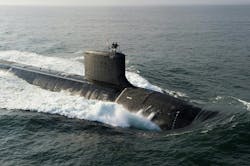Navy asks General Dynamics to prepare building 39th Virginia Class submarine, electronics, and electro-optics
WASHINGTON – U.S. Navy undersea warfare experts are asking General Dynamics Electric Boat in Groton, Conn., to prepare building the 39th Virginia-class fast attack submarine under terms of a potential $53.6 million order announced in December.
Officials of the Naval Sea Systems Command in Washington are asking Electric Boat to procure long lead time and materials for building the yet-unnamed Virginia-class SSN 812. A major subcontractor to General Dynamics is Huntington Ingalls Industries' Newport News Shipbuilding division in Newport News, Va.
Long-lead items either are difficult and time-consuming to obtain, and are funded early in the aircraft design process to keep overall production on schedule. Contracts to build the missile will come later.
The latest Virginia-class fast-attack submarines will have additional vertical-launch missile tubes called the Virginia Payload Module (VPM). General Dynamics Electric Boat is a subsidiary of General Dynamics Corp.
The Virginia Payload Module is a mid-body section on the centerline of the submarine that contains four additional Virginia Payload Tubes that replace single-purpose cruise missile launch tubes.
The VPM increases the overall length of the submarine, and enables the Virginia-class submarine to carry as many as 28 additional Tomahawk cruise missiles, similar munitions, or unmanned underwater vehicles (UUVs). Each of the four VPM tubes can fit as many as seven Tomahawk missiles.
Compared to their predecessors such as the U.S. Seawolf- and Los Angeles-class attack submarines, the Virginia class boats offer several electronic, electro-optics, and propulsion innovations not previously built into other submarine classes.
The Virginia class, for the first time, has no opening in its pressure hull through which a conventional periscope raises and lowers. Instead, the nation's newest submarine class have photonics masts with high-resolution daylight cameras, light-intensification and infrared sensors, an infrared laser rangefinder, and special submarine electronics to intercept enemy communications.
Instead of passing through an opening in the boat's pressure hull, which can create a weak spot in combat, signals from photonics mast sensors enter the submarine via optical fiber for signal processing in the boat's command center.
In addition, the Virginia class also has improved sonar systems and electromagnetic signature reduction to reduce the possibility of enemy detection. The boat has a bow-mounted spherical active and passive sonar array, a wide aperture lightweight fiber optic sonar array, and two high-frequency active sonars in the sail and keel.
The Virginia class also has low-frequency and high-frequency towed sonar arrays, a chin-mounted high-frequency sonar to supplement the boat's main sonar array for operations in coastal waters and to detect enemy submarines.
Instead of traditional bladed propellers, the Virginia class has pump-jet propulsors to reduce the risks of cavitation and enable quieter operation than traditional propellers allow. The boat also has fiber-optic fly-by-wire ship control, AN/BYG-1 combat system, and nine-man lockout chamber for covert insertion of Special Operations forces.
Virginia-class submarines are designed for anti-submarine and surface ship warfare and special operations support, as well as intelligence, surveillance, and reconnaissance (ISR). They are to replace legacy Los Angeles-class attack submarines as the older boats are retired. Los Angeles-class subs have been at sea since the 1970s.
Electric Boat and Newport News Shipbuilding already have delivered 19 Virginia-class submarines to the Navy. Nine additional submarines are under construction.
Without the Virginia Payload Module, Virginia-class submarines displace 7,800 tons, are 377 feet long, and 34 feet in diameter. They can travel faster than 25 knots and dive deeper than 800 feet. They carry Mark 48 advanced capability torpedoes, Tomahawk land-attack missiles, and unmanned underwater vehicles (UUVs).
On this order General Dynamics Electric Boat will do the work in Spring Grove, Ill.; Orrville and Salem Ohio; Arlington, Texas; Bozrah and South Windham, Conn.; Warren and Mansfield, Mass.; Monroe, N.C.; Jacksonville, Fla.; Florence, N.J.; Farmingdale and Yaphank, N.Y.; Norfolk, Va.; and Benicia, Calif., and should be finished by by September 2033.
For more information contact General Dynamics Electric Boat online at www.gdeb.com, Newport News Shipbuilding at https://hii.com/what-we-do/divisions/newport-news-shipbuilding/, or Naval Sea Systems Command at www.navsea.navy.mil.

